
The news was shocking, and devastating. A champion Paso Fino stallion in his prime suffered catastrophic heart failure and could not be saved.
But there was a chance to save the bloodline of Portal de Luisa. In the last hour before he was euthanized, New Bolton Center veterinarians used techniques developed at Penn Vet to collect the stallion’s sperm without compromising his comfort.
Owner Beaverlea Manderbach hoped to continue Portal’s legacy at her Laota Spring Farm in Sinking Spring, PA. Using the collected sperm, New Bolton Center’s reproduction specialists artificially inseminated one of her most-prized Paso Fino mares. Successful, Maggie is due to foal in July.
“The death of Portal was a huge loss to Beaverlea, but she now has proven fertile sperm preserved from the horse, and at least one foal on the way, hopefully more,” said Dr. Regina Turner, Associate Professor of Reproduction at New Bolton Center’s Hofmann Center for Reproduction.
A Stallion’s Heart
Suddenly last summer Portal wasn’t his usual, responsive self. He was off his feed, losing weight. His veterinarian heard a heart murmur during an exam, and referred him to New Bolton Center. Drs. Virginia Reef, Director of Large Animal Cardiology and Ultrasound, and Fe ter Woort, Cardiology Fellow, took the case and ordered an echocardiogram.
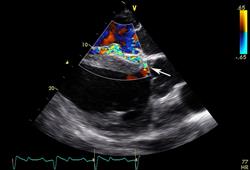 “He had a tear, a little hole, in his aorta (aortocardiac fistula), which communicated with his heart’s right ventricle,” said Reef, also a Professor of Medicine and Chief of Sports Medicine and Imaging. “Blood was leaking into the right ventricle, overloading the heart and making him go into heart failure.”
“He had a tear, a little hole, in his aorta (aortocardiac fistula), which communicated with his heart’s right ventricle,” said Reef, also a Professor of Medicine and Chief of Sports Medicine and Imaging. “Blood was leaking into the right ventricle, overloading the heart and making him go into heart failure.”
The blood from the hole in the aorta dissects into the heart muscle, and as the pressure builds up, the endocardium, the tough coating on the heart muscle, breaks, Reef said. Portal’s heart defect was not congenital, but acquired during his life, she added. “What triggered it is really unknown,” she said.
Because the aorta is the largest artery in the body, it was too risky to try to keep the horse alive, as he could experience sudden cardiac death, putting anyone around him in danger, Reef said.
“It’s not fixable in a horse. It would require open heart surgery,” Reef said. “Any horse with any damage to the aorta is not safe to ride or drive, or even handle for breeding.”
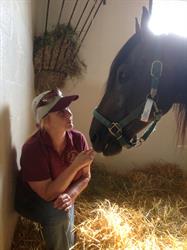 Portal, at 10 years old, was at the pinnacle of his career when his heart gave out. A champion at national and international shows, his list of accomplishments is impressive, including being named the World Cup Classic Fino Champion and the National Classic Fino Champion.
Portal, at 10 years old, was at the pinnacle of his career when his heart gave out. A champion at national and international shows, his list of accomplishments is impressive, including being named the World Cup Classic Fino Champion and the National Classic Fino Champion.
“He went from this magnificent, beautiful stallion to one that didn’t have long. I’ve never seen a horse change that much,” said Manderbach. “I couldn’t believe what I was seeing.”
Sought after for breeding, Portal embodied the superlatives of the Paso Fino, a Spanish breed known for its smooth-as-glass, four-beat gait.
“His blood lines were amazing, but not common. His performance in the show ring was phenomenal,” Manderbach said. “He was gorgeous.”
Turning to the experts at the Hofmann Center, Manderbach asked if there was anything to be done. Dr. Turner said there were some options.
“I said yes, let’s do it, let’s try,” Manderbach said.
Using New Bolton Center’s Techniques
Portal was too debilitated, his heart too weak, to withstand the effort of mounting and ejaculating in the usual way, Turner said. “So we tried a combination of techniques to try to get the best sperm that we could, and as much of it as we could without putting any strain on the stallion,” she said.
Using a technique developed by New Bolton Center’s Dr. Sue McDonnell, it is possible to create a spontaneous ejaculation by using a very specific dose of the sedative xylazine under very controlled conditions, Turner said. “We were lucky. It worked,” she said, noting that semen was immediately frozen for future use.
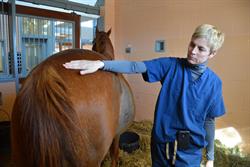 Manderbach was there during the procedure. “I stayed with him. When it was time to put him down, we walked him over, we took him in, and I held him. And that was it,” she said. “It was so emotional.”
Manderbach was there during the procedure. “I stayed with him. When it was time to put him down, we walked him over, we took him in, and I held him. And that was it,” she said. “It was so emotional.”
Once Portal was deceased, Dr. Turner and Dr. Jenn Linton, Resident in Reproduction, removed his testicles and used a procedure to retrieve additional sperm. Billions of sperm were recovered and frozen to add to the ejaculated frozen sperm.
“We harvest the epididymis, the part of the testicles that allows for the storage and maturation of the sperm,” said Dr. Tamara Dobbie, staff veterinarian and Hofmann Center Director. The procedure is used to preserve sperm for future use from deceased stallions, and also from the testicles of those just castrated.
Trying for a Foal
The hope was to use Portal’s sperm to impregnate one of the farm’s Paso Fino mares. Arriving back to the farm after Portal’s death, Manderbach discovered, to her surprise, that one of their favorites, 14-year-old Maggie, was in heat and nearly ready to be bred.
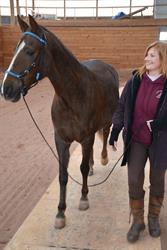 “We loaded her up the next day and took her down to New Bolton,” Manderbach said. Confirming Maggie had follicles just about to ovulate, Dobbie agreed she was ready to be bred.
“We loaded her up the next day and took her down to New Bolton,” Manderbach said. Confirming Maggie had follicles just about to ovulate, Dobbie agreed she was ready to be bred.
Dobbie gave Maggie an agent to induce ovulation within 48 hours, and checked her every six hours around the clock. By 7 a.m. on August 31, she confirmed ovulation, and bred Maggie by artificial insemination, using the frozen semen from Portal.
“We have a very long catheter that we guide rectally into the uterine body and to the tip of the uterine horn,” Dobbie said. “The semen is deposited deep in the uterus, near the oviductal papilla, so the sperm does not have far to travel to get into the oviduct, site of fertilization.”
Veterinarians at the Hofmann Center routinely apply this type of intensive breeding management to result in pregnancies in mares bred with frozen semen.
So Far, So Good
By September 12, Maggie was diagnosed as pregnant. The mare stayed at the Hofmann Center for several weeks, until veterinarians confirmed a strong heartbeat and normal development in the embryo.
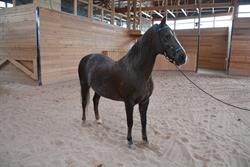 Maggie looked splendid during a recent visit to Laota Spring Farm, which sits up on a hill that is part of the farm Manderbach inherited from her grandfather. In fine shape, Maggie was full of energy as she was turned loose in the indoor arena.
Maggie looked splendid during a recent visit to Laota Spring Farm, which sits up on a hill that is part of the farm Manderbach inherited from her grandfather. In fine shape, Maggie was full of energy as she was turned loose in the indoor arena.
An ultrasound in January confirmed that the pregnancy is progressing nicely, Manderbach said.
“The baby is healthy, the heart rate is good. Mom and baby are doing wonderfully,” she said. “We are happy.”